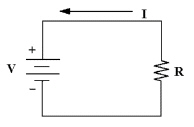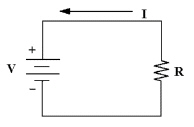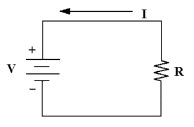True/False
Indicate whether the
statement is true or false.
|
|
|
1.
|
If the current is constant,
voltage and resistance are directly proportional.
|
|
|
2.
|
If a circuit's supply voltage is 15 V and its
resistance is 4700 Ù, its current is 3.19 mA.
|
|
|
3.
|
If a 1 kÙ resistor has 32 mA flowing through
it, it dissipates 1.024 W.
|
|
|
4.
|
If a circuit's resistance
increases, its current decreases.
|
|
|
5.
|
If a 47 kÙ resistor
carries 5 mA, it's safe to use a 1 W resistor.
|
|
|
6.
|
If a circuit's supply voltage is 20 V and its
resistance is 3300 Ù, its current is 6.06 mA.
|
|
|
7.
|
If a 2.5 kÙ resistor carries 45 mA, it is
dissipating 5.0625 W.
|
|
|
8.
|
If a 56 kÙ resistor carries 10 mA, it is safe
to use a 10 W resistor.
|
|
|
9.
|
If a 12 kÙ resistor carries 12 mA, the
resistor drops 1 V.
|
|
|
10.
|
If the voltage applied to a
circuit doubles, then power dissipation doubles.
|
Multiple Choice
Identify the
choice that best completes the statement or answers the question.
|
|
|
11.
|
Voltage and current are
________.
a. | inversely
proportional | c. | directly
proportional | b. | quantities that add | d. | unrelated |
|
|
|
12.
|
If the voltage across a circuit
increases, ________.
a. | the resistance
increases | c. | the resistance
decreases | b. | the current increases | d. | the current decreases |
|
|
|
13.
|
According to Ohm's Law, if
voltage were to decrease while resistance remained the same, current would
a. | remain the
same | c. | decrease | b. | increase | d. | no way to determine |
|
|
|
14.
|
According to Ohm's Law, if
voltage were to increase while resistance remained the same, current would
a. | increase | c. | no way to determine | b. | decrease | d. | remain the same |
|
|
|
15.
|
According to Ohm's Law, if
resistance were to decrease while voltage remained the same, current would
a. | no way to
determine | c. | remain the
same | b. | increase | d. | decrease |
|
|
|
16.
|
If V = 25 V and R = 50
kÙ in Figure 3-1, the current equals ________.

Figure 3-1
a. | 0.5 mA | c. | 50 mA | b. | 2 mA | d. | 5 mA |
|
|
|
17.
|
If I = 64 mA and R = 470 Ù in Figure 3-1, the
voltage equals ________.

Figure
3-1
a. | 7.34 V | c. | 73.4 V | b. | 30.1 V | d. | 3.01 V |
|
|
|
18.
|
If V = 72 V and I = 12 mA in
Figure 3-1, the resistance equals ________.

Figure
3-1
a. | 0.166 Ù | c. | 6
kÙ | b. | 864 Ù | d. | 47
kÙ |
|
|
|
19.
|
If V = 12 V and a 12 kÙ resistor shorts in
Figure 3-1, the current is ________.

Figure
3-1
a. | 1 mA | c. | 10 mA | b. | 0 A | d. | extremely high |
|
|
|
20.
|
If the resistor opens in Figure
3-1, the following circuit conditions would exist.

Figure 3-1
a. | resistor would read infinite
resistance | c. | no current
flow | b. | no power dissipation | d. | all of the above |
|
|
|
21.
|
If V=12V and a 12kÙ resistor were to open in
Figure 3-1, the current is ________.

Figure
3-1
a. | 0 A | c. | 1 mA | b. | 10 mA | d. | extremely high |
|
|
|
22.
|
If the voltage is suddenly
switched off in Figure 3-1, ________.

Figure
3-1
a. | the current will first increase and
then decrease to 0 A | b. | the current will gradually decrease to 0 A | c. | the current will suddenly drop to 0
A | d. | there is no way to predict the
current |
|
|
|
23.
|
If V = 100 V and I = 1 mA in
Figure 3-1, the power dissipated by the resistor equals ________.

Figure 3-1
a. | 1 W | c. | 10 W | b. | 10 mW | d. | 100 mW |
|
|
|
24.
|
If I = 32 mA and R = 469 Ù in Figure 3-1, the voltage equals ________.

Figure 3-1
|
|
|
25.
|
If the voltage were suddenly
switched on in Figure 3-1, ________.

Figure
3-1
a. | the current would gradually decrease
and then increase | b. | the current would gradually decrease | c. | the current would be
zero | d. | the current would flow |
|
|
|
26.
|
If I = 27 mA and R = 4.7 Ù in Figure 3-1, the
voltage equals ________.

Figure
3-1
a. | 5.74 V | c. | 7.8 V | b. | 174 mV | d. | 127 mV |
|
|
|
27.
|
What is the resistance of a 100
W bulb when it is operating in a circuit with a supply of 120 V?
a. | 144 Ù | c. | 2.14
Ù | b. | 56 Ù | d. | 560
Ù |
|
|
|
28.
|
If a resistor is rated at 1/2
W, it ________.
a. | can safely dissipate 1/2 W of
power | b. | always dissipates 1/2 W | c. | can only dissipate more than 1/2 W of
power | d. | always provides 1/2 W of power |
|
|
|
29.
|
Which is the correct formula
for Ohm's Law?
a. | R = V ×
I | c. | I = V ÷
R | b. | P = V ×
I | d. | V = I ÷
R |
|
|
|
30.
|
If a resistor that is
color-coded yellow-violet-brown-gold is connected to a 12 V source, then what is the current
flow?
a. | 25.5 mA | c. | 24.3 mA | b. | 255 mA | d. | 26.9 mA |
|
|
|
31.
|
Resistance and current are
________.
a. | inversely
proportional | c. | similar to
voltage | b. | directly proportional | d. | not related |
|
|
|
32.
|
A 250 ìA current flowing through a 4.7 kÙ
resistor produces a ________ voltage drop.
a. | 53.2 V | c. | 1.18 V | b. | 18.8 V | d. | 1.18 mV |
|
|
|
33.
|
If a resistance of 2.2 MÙ is connected across
a 1 kV source, current equals about ________.
a. | 45.5 ìA | c. | 0.455 A | b. | 2.2 mA | d. | 0.455
mA |
|
|
|
34.
|
If a 330 Ù resistor
dissipates 2 W, its voltage drop equals ________.
a. | 2.57 V | c. | 660 V | b. | 25.7 V | d. | 6.6 V |
|
|
|
35.
|
What is the resistance of a 150
W bulb when it is operating in a circuit with a supply of 125 V?
a. | 9375 Ù | c. | 75
Ù | b. | 2.14 Ù | d. | 104
Ù |
|
|
|
36.
|
Which is the correct formula
for finding power?
a. | P = V ×
I | c. | P = I2 ×
R | b. | P = V2 ÷
R | d. | all of these |
|
|
|
37.
|
If a resistor that is
color-coded red-red-brown-silver is connected to a 15 V source, what is the maximum current that can
flow?
a. | 71.9 mA | c. | 75.8 mA | b. | 62 mA | d. | 68.2 mA |
|
|
|
38.
|
Using Watt's law and
substituting power can be calculated as ________.
a. | P =
V2/R | c. | P =
I2R | b. | P = VI | d. | all of
these |
|
|
|
39.
|
Power as it is used in electric
circuits can be best defined as:
a. | the rate current flows over
time. | c. | the rate voltage is applied over
time. | b. | the rate energy is used over time. | d. | the rate motion is exerted over
time. |
|
|
|
40.
|
The symbol for a certain amount
of energy used over time is ________.
|
|
|
41.
|
A kilowatt-hour is best defined
as:
a. | 1,000 watts multiplied by 1
hour. | c. | a kilo multiplied by 1
watt-hour. | b. | 1,000 watts divided by 1 hour. | d. | a kilo divided by 1 watt-hour. |
|
|
|
42.
|
The ampere-hour rating of a
battery is defined as the:
a. | number of amperes supplied in 1
hour. | b. | number of hours per amperes supplied. | c. | number of amperes supplied over the number of hours at a
given current. | d. | all of these. |
|
|
|
43.
|
If the current flow for a given
circuit has doubled, then the ________ has been halved.
a. | resistance | c. | current | b. | power | d. | voltage |
|
|
|
44.
|
In the operation of electrical
circuits, which, in most cases, is an unwanted by-product?
a. | mechanical
motion | c. | light | b. | heat | d. | both B and
C |
|
|
|
45.
|
Typically, which is the first
type of measurement taken in a known defective circuit?
a. | voltage | c. | resistance | b. | power | d. | current |
|